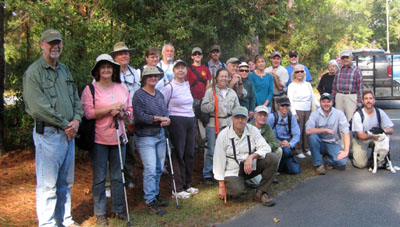Field trip to Torreya State Park with Gil Nelson: Part 1
 On the Saturday before Thanksgiving, 25 members from three different chapters of the Florida Native Plant Society joined up with Florida plant guru Gil Nelson at Torreya State Park. The park, located west of Tallahassee, borders the Apalachicola River. You may have noticed that several books that we recommend over there on the right hand column are by Gil.
On the Saturday before Thanksgiving, 25 members from three different chapters of the Florida Native Plant Society joined up with Florida plant guru Gil Nelson at Torreya State Park. The park, located west of Tallahassee, borders the Apalachicola River. You may have noticed that several books that we recommend over there on the right hand column are by Gil.What a great way to spend a beautiful north Florida November day--out in the woods with folks who are interested in not only plants, but the bugs, snakes and the whole ecosystem. After posing for the initial photo (Gil is on the left of this group photo.), we were off into the woods. (Note: For this post, I have included links to webpages with more information on the specimen being discussed.)
 Here Gil shows folks how to look for hairy undersides of leaves to help identify this tree that many people confuse with oaks, but instead it's a gum bully (Sideroxylon lanuginosum). It also has thorns and bluish berries, which might be a hint that this is not an oak.
Here Gil shows folks how to look for hairy undersides of leaves to help identify this tree that many people confuse with oaks, but instead it's a gum bully (Sideroxylon lanuginosum). It also has thorns and bluish berries, which might be a hint that this is not an oak.
 |
| The needle palms dotted the woods. |
The saw palmetto (Serenoa repens) is much more widespread. You can see the triangle at the top of the stalk and you can also see that the leaf sections are connected farther out from the stalk.
 |
| In case you wanted to know why they are called needle palms... It's those sharp needles! |
 |
| Saw palmetto for comparison |
 |
| A Pine Woods Snake |
This Florida redbellysnake (Storeria occipitomaculata) was warming itself on the sandy trail.
Gil explains that the fruiting structure of the southern magnolia (Magnolia grandiflora) is not a cone, but a woody aggregate fruit made up of many follicles, the seeds of which are covered with bright red fleshy coatings that attract birds. There are four magnolias species growing in Torreya State Park. In addition to the southern magnolia, there are Ashe's magnolia (M. macrophylla var. ashei), and pyramid magnolia (M. pyramidata), which are limited to the panhandle in Florida, plus the wide-spread sweet bay magnolia (M. virginiana). We saw them all, plus we also saw some tulip trees (Liriodendron tulipifera), which belong to the magnolia family.
 |
| What is everyone looking at on the ground? |
 |
| There are beechdrops under the beech trees. |
Beechdrops (Epifagus virginiana) are parasitic flowering plants that lack leaves and produce no chlorophyll. They are only found in the vicinity of beech trees (Fagus grandifolia). In Florida they are limited to the panhandle.
 We spotted several species of hawthorn (Crategus spp). There are several species in the park--apple haw (C.aestivalis), summer haw (C. flava), parsley haw (C.marshallii), and green haw (C. viridis). There are lots of one-flower haws (C. uniflora) and beautiful haws (C. pulcherrima) in the park. We also saw littlehip hawthorn (C. spathulata), which is pretty common, too. And then just to confuse the subject there is also possumhaw (Ilex decidua) or (Viburnum nudum), neither of which is not a hawthorn, but a deciduous holly or a viburnum, and then there's the southern or rusty black-haw (Viburnum rufidulum)--another viburnum.
We spotted several species of hawthorn (Crategus spp). There are several species in the park--apple haw (C.aestivalis), summer haw (C. flava), parsley haw (C.marshallii), and green haw (C. viridis). There are lots of one-flower haws (C. uniflora) and beautiful haws (C. pulcherrima) in the park. We also saw littlehip hawthorn (C. spathulata), which is pretty common, too. And then just to confuse the subject there is also possumhaw (Ilex decidua) or (Viburnum nudum), neither of which is not a hawthorn, but a deciduous holly or a viburnum, and then there's the southern or rusty black-haw (Viburnum rufidulum)--another viburnum.Here Gil shows us how to identify the green haw by the bark and thorns on the trunk. It's always good to have a definitive marker.
A grizzled mantid (Gonatista grisea), a relative of the more abundant praying mantis, is also known as a lichen mimic. Here you see a mantid, disguised on the trunk of a white oak tree. It's astonishing that someone noticed it, but then Ron Houser also noticed the purse web spider's (Sphodros spp) unique webs.
We didn't see the spider, which is related to tarantulas, but saw several of the tube-shaped webs at the base of trees. The spiders hide in the tubes and pop out the trap door on top and drag their prey into the tubes. the female raise their babies in the tubes, too. Who knew?
Ginny Stibolt






Comments
V. Avery
Ginny